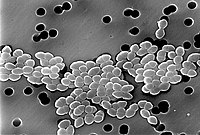
Photo from wikipedia
OBJECTIVE To determine the current antibiotic resistance patterns and identification of quinolone and ceftriaxone resistant genes among Salmonella enterica subspecies serovar Typhi. METHODS The prospective study was conducted from September… Click to show full abstract
OBJECTIVE To determine the current antibiotic resistance patterns and identification of quinolone and ceftriaxone resistant genes among Salmonella enterica subspecies serovar Typhi. METHODS The prospective study was conducted from September 2018 to March 2019 and comprised samples collected from major hospitals and laboratories in Karachi, Quetta, Lahore, Kharia, Rawalpindi, Islamabad and Peshawar after approval from the institutional ethics review board of Hazara University, Mansehra, Pakistan. Antimicrobial susceptibility of isolates collected from the health facilities was checked using the Kirby Bauer disc diffusion method in line with the Clinical and Laboratory Standards Institute guidelines at the Department of Microbiology, Armed Forces Institute of Pathology (AFIP), Rawalpindi, Pakistan. All isolates were subjected for identification of genes responsible for quinolone and ceftriaxone resistance using polymerase chain reaction followed by gel-electrophoresis. RESULTS Among the 96 isolates, phenotypically, ceftriaxone was found resistant in 31(32.29%) and ciprofloxacin in 95(99%). Genotypically, blaCTX-M-15 (beta lactamase, CTX as its acronym, -M from Munich) gene for ceftriaxone resistance was found in all phenotypically resistant 31(32.29%) isolates, while QnrS (Quinolone resistance, S group), GyrA (DNA gyrase subunit A), and GyrB (DNA gyrase subunit B) genes responsible for ciprofloxacin resistance were found in different frequencies (percentages given in table 2). CONCLUSIONS The spread of extensively drug-resistant Salmonella enterica subspecies serovar Typhi strain to many big cities calls for urgent preventive measures.
Journal Title: JPMA. The Journal of the Pakistan Medical Association
Year Published: 2022
Link to full text (if available)
Share on Social Media: Sign Up to like & get
recommendations!